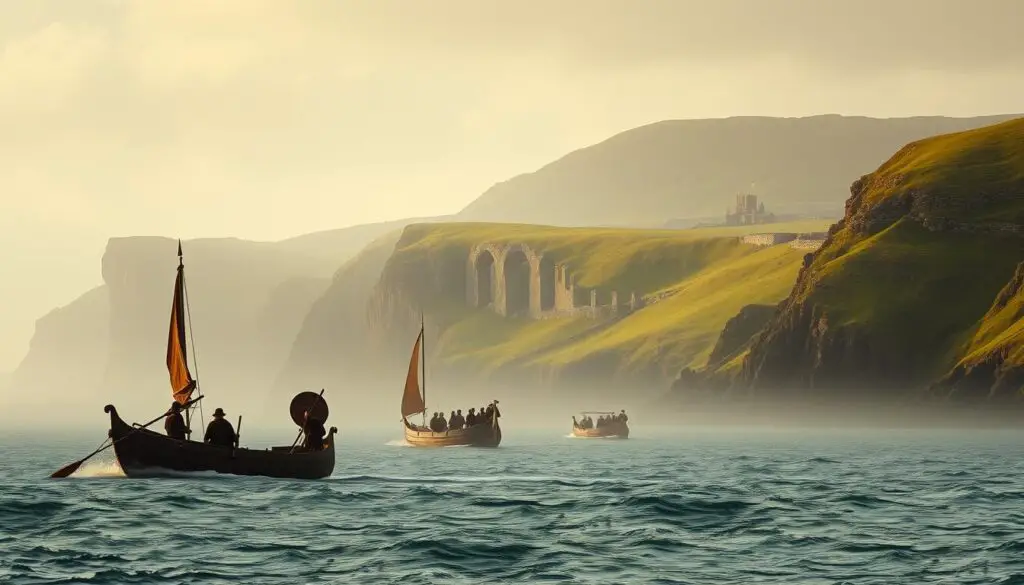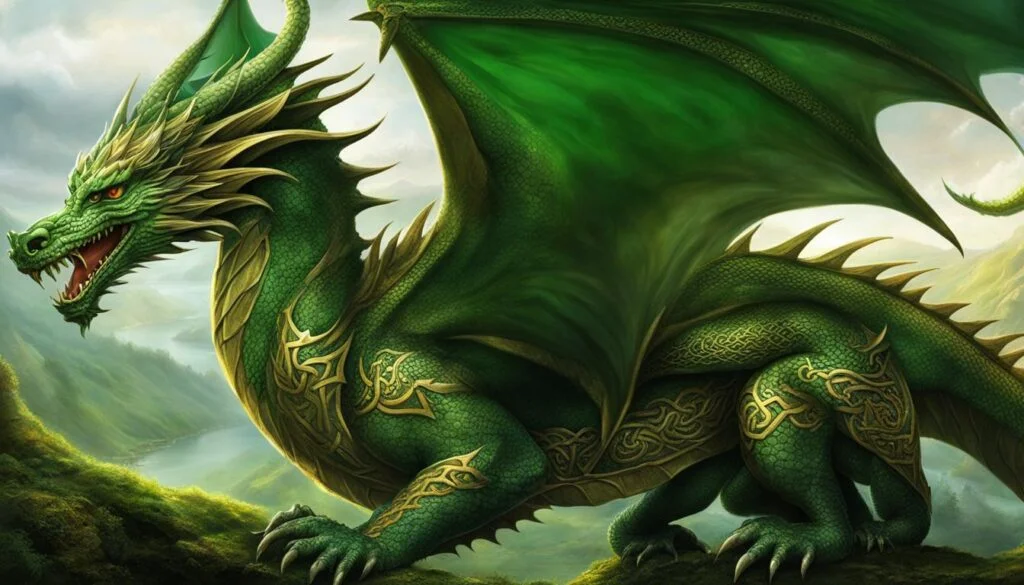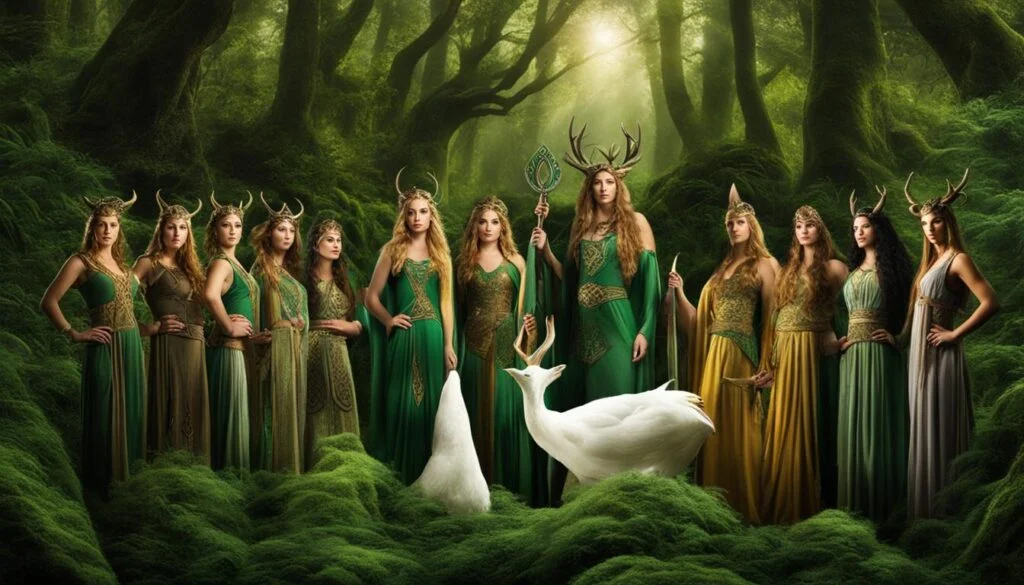The Milesians, known as ancient Irish settlers, are believed to be the final race to settle in Ireland, deeply rooted in Irish mythological origins.
These Gaelic migrants, portrayed as descendants of Míl Espáine, are central figures in the Lebor Gabála Érenn — a medieval Christian interpretation of Irish history.
Their legendary journey from the regions of Scythia to Iberia and ultimately to Ireland highlights complex Celtic migrations and intertwines with biblical narratives.
This mythology not only contributed to the cultural landscape of medieval Ireland but also aimed to align Irish heritage with esteemed biblical ancestries.
Key Takeaways
- The Milesians are central to Irish mythological origins.
- They are depicted as descendants of Míl Espáine.
- The Lebor Gabála Érenn traces their journey from Scythia to Iberia and finally to Ireland.
- The myth served to Christianize native Irish myths.
- The narrative was accepted as historical truth in Ireland until the 19th century.
Introduction to the Milesians in Irish Mythology
In the rich tapestry of Irish mythology, the Milesians stand as pivotal figures representing the final wave of prehistoric Irish settlers.
These legendary ancestors, often referred to as the Milesian ancestors, embarked on an epic journey from Iberia to the mystical land of Ireland.
Their story is intricately woven into the Gaelic ancestral tales, reflecting Ireland’s deep-rooted connection to its mythological past.
Records from the Lebor Gabála Érenn, or the Book of Invasions, chronicle this saga, showcasing the trials and tribulations faced by the Milesians.
Among the notable figures is Míl Espáine, also known as Milesius in Latin, who is revered as the mythical ancestor of the Irish Gaels.
Although Milesius perished before reaching Ireland, his legacy was carried forward by his wife, Scota, and their descendants.
Their arrival in Ireland marked a significant clash with the divine Tuatha Dé Danann, who had reigned over Ireland for centuries.
The ensuing battles and the eventual triumph of the Milesians over the Tuatha Dé Danann are central themes in Gaelic ancestral tales.
This conquest not only secured their place in Irish mythology but also symbolized the emergence of a new era for the Irish people.
The mythological impact of the Milesians extends beyond mere tales.
Their story has intertwined with Ireland’s cultural and spiritual identity, influencing everything from ancient festivals to modern interpretations in literature and art.
As these Gaelic ancestral tales continue to captivate audiences, the legacy of the Milesian ancestors remains a testament to the enduring power of Irish mythology.
The Lebor Gabála Érenn and Its Influence
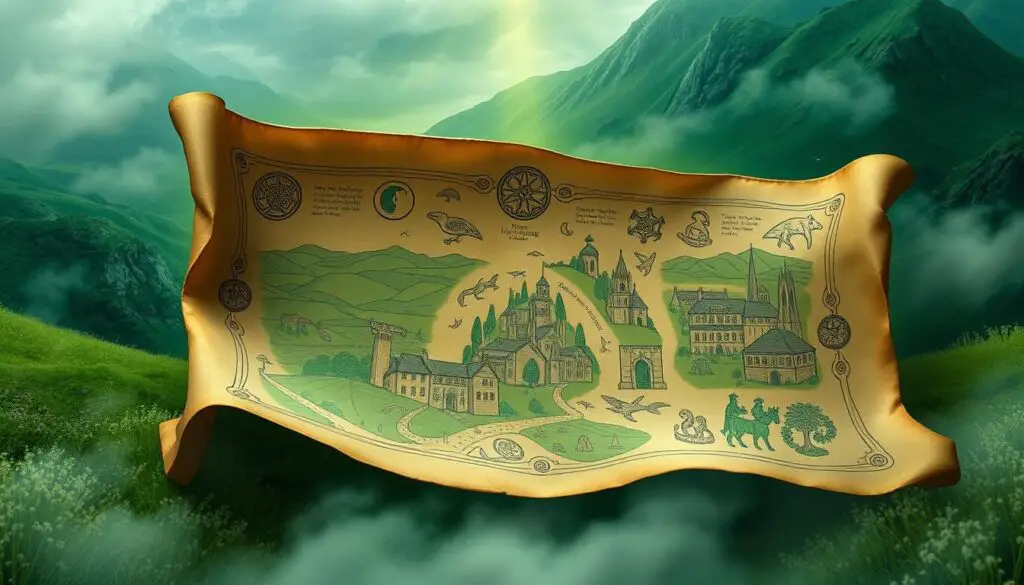
The Lebor Gabála Érenn, known as the “Book of the Taking of Ireland,” stands as a cornerstone of ancient Irish mythology and medieval literature.
This text is recorded in more than a dozen medieval manuscripts, such as the Book of Leinster, and offers a pseudo-historical account of Ireland’s origins.
Origins and Compilation
The compilation of the Lebor Gabála Érenn spans centuries, with the earliest version being pieced together in the 11th century.
The text was originally written in Middle Irish and comprises around 136 poems across multiple versions.
It narrates the stories of Ireland being settled six times by different groups: the people of Cessair, Partholón, Nemed, Fir Bolg, Tuatha Dé Danann, and the Milesians.
Scholars debated its historical accuracy until the late 19th century, with Eoin MacNeill being the first to openly question its literal interpretation.
The Connection to the Old Testament
The Lebor Gabála Érenn intertwines Gaelic lore with biblical narratives, aiming to present the Gaels as noble descendants of biblical patriarchs.
The text tells of tribes stemming from Fénius Farsaid, a descendant linked to the story of the Tower of Babel, thereby aligning Gaelic myth with Judeo-Christian teachings.
This correlation mirrors the Israelites’ journey, shaping a Christianized history of Ireland. Influences from texts like St.
Augustine’s City of God and Isidore of Seville’s Etymologiae are evident in its structure, reflecting the medieval writers’ efforts to provide a cohesive pseudo-historical account.
Significance in Medieval Literature
Throughout the Middle Ages, the Lebor Gabála Érenn was viewed as credible history, profoundly influencing poets and scholars.
Edited by R.A.S. MacAlister for the Irish Text Society and published in five parts between 1938 and 1956, the text showcases five different redactions found in manuscripts like the Book of Ballymote.
This renowned work was integral in unifying the Irish population under a shared mythological ancestry, converting pagan deities into human heroes and legitimizing dynastic lineages.
The text, considered a seamless blend of fact and fiction, continues to be a significant subject of study in ancient Irish mythology and medieval literature today.
Who Were Milesians: Unveiling Their Identity
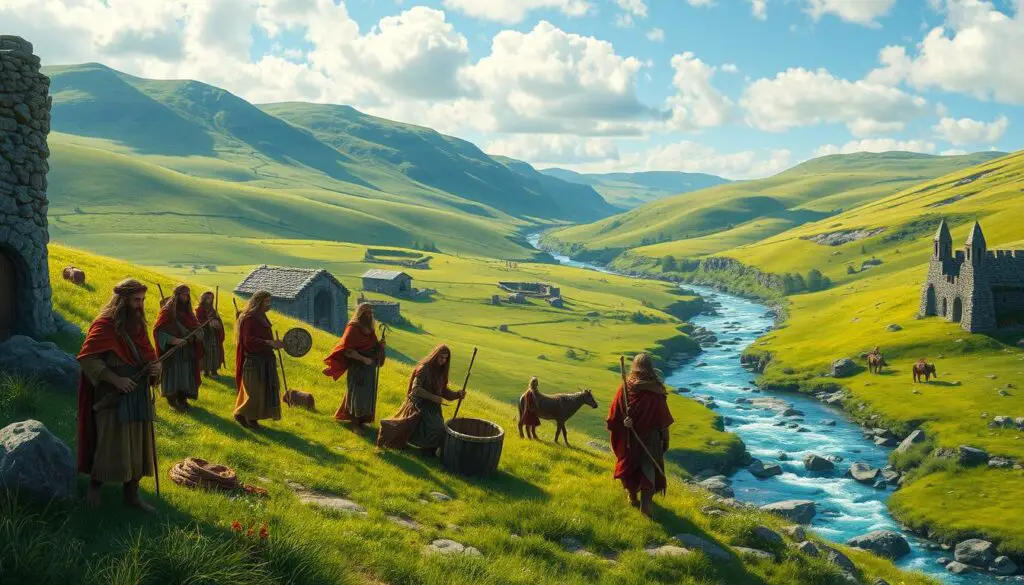
The Milesians, as depicted in Irish mythological origins, are fascinating figures who claim a rich heritage.
These ancient settlers are often seen as descendants of Míl Espáine, a noble figure linked to Iberia, or modern-day Spain.
This lineage traces back to ancient Scythia through a series of legendary ancestors.
With a strong connection to the Goidelic peoples and their language, these tales have been woven into the very fabric of Irish storytelling, passed down through generations.
Descendants of Míl Espáine
According to the legends, the Milesians emerged as a prominent group with deep ties to Míl Espáine.
This figure is often seen as a cornerstone of the Milesian identity, representing a bridge between Iberia and Ireland.
These descendants were known not only for their noble lineage but also for their interactions with the Tuatha Dé Danann.
By integrating through intermarriage, the Milesians influenced and were influenced by the beliefs and customs of the earlier inhabitants.
The Goidelic Peoples and Their Ancestry
The Milesians’ roots go deeper into the history of the Goidelic peoples. Their ancestry is often linked to Goídel Glas and Scota, the daughter of an Egyptian pharaoh.
This mythological connection enhances their status within Irish society, tying them to prominent figures and places.
Sites like Tara and ancient hill forts remind us of their enduring legacy. Notably, revered dynasties, such as the Uí Néill and the Eóganachta, claim descent from the Milesians, underscoring their influence and integration.
The identity of the Milesians is intricately linked to the broader tapestry of Irish mythological origins.
Their interactions with other groups have led to a synthesis of beliefs and practices, leaving an indelible mark on history.
For those interested in exploring similar cultural and historical intersections, the roles of the Druids in Celtic societies offer compelling insights.
The Journey from Scythia to Iberia
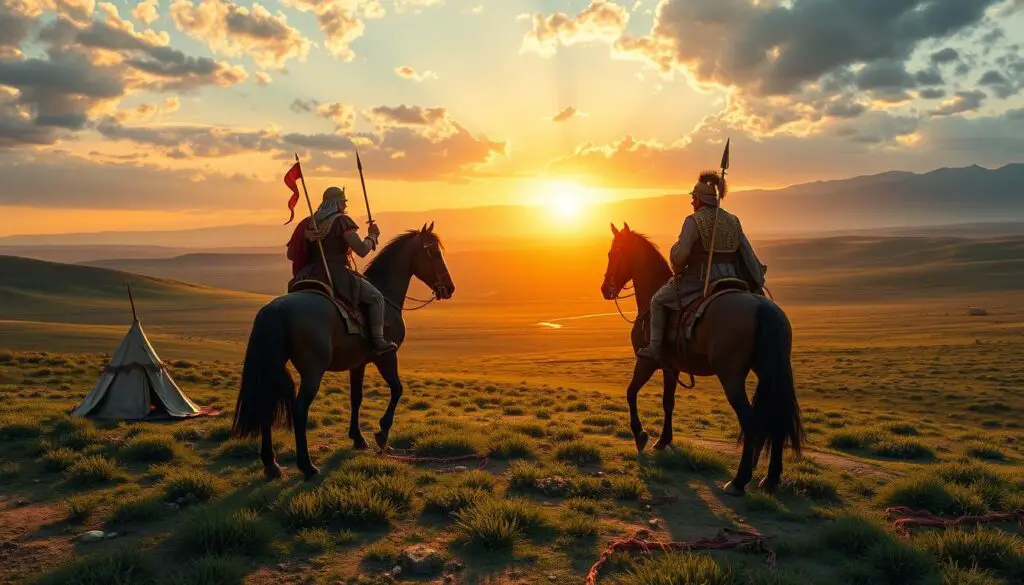
The journey of the Milesians from Scythia to Iberia is an epic tale ingrained in Irish mythology.
Their origins are traced back to the Greek city of Miletus on the coast of Anatolia around 1,250 to 1,150 BCE.
From there, they embarked on extensive travels that included sojourning in Egypt, northward to Scythia, and eventually settling in the Iberian Peninsula.
Scythian Origins
The Milesians’ roots in Scythia provide a fascinating glimpse into their early history.
According to Irish mythology, they spent several centuries in Scythia, a period during which they further developed their distinctive culture and identity.
The Scythian connections are significant as they underscore the blend of influences that shaped the Milesian lineage.
Settling in Iberia
Continuing their extensive journey, the Milesians eventually reached the Iberian Peninsula, often considered their final staging ground before their legendary invasion of Ireland around 1,000 BCE.
Settling among various Celtic tribes in northern Iberia, they absorbed elements from the local cultures and also contributed to the broader tapestry of Iberian migrations.
Under the leadership of Míl Espáine, or “Soldier of Hispania,” they established a robust cultural foothold, which would later influence their conquest of Ireland.
The Final Voyage to Ireland
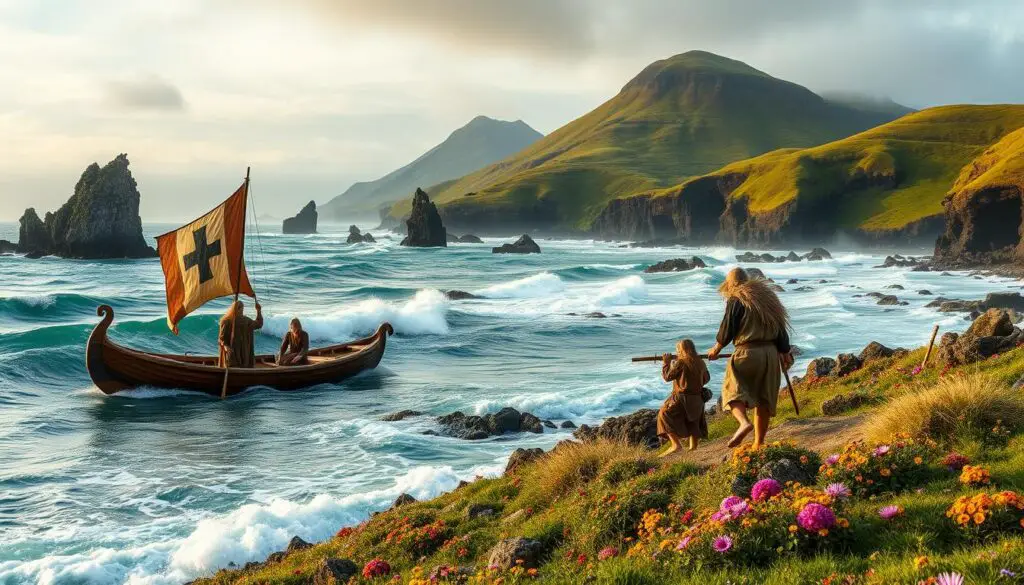
The tale of the ancient Irish settlers reaches its climax with their daring final voyage from Iberia to Ireland.
This significant expedition, led by the sons of Míl Espáine, was catalyzed by the death of their uncle Íth.
With a deep sense of purpose, they set their course toward Ireland, the land they aimed to claim from the incumbent Tuatha Dé Danann.
The journey of these prehistoric Irish settlers was fraught with challenges. Under constant threat from the powerful magic of the Tuatha Dé Danann, the Milesians navigated through nine perilous waves before making landfall.
Their fleet, composed of 65 ships led by 40 chiefs, first touched the shores of Kerry, before moving towards Tara, the heartland of Ireland.
Despite the Tuatha Dé Danann’s formidable opposition, the Milesians succeeded in defeating them three days after their arrival, a testament to their resilience.
This victory marked a turning point, allowing the ancient Irish settlers to assert their dominion over the land. To ensure a just distribution of territory, northern Ireland was entrusted to Eremon, while the southern half went to Eber.
The significance of their triumph was celebrated through symbolic acts—the north of Ireland became renowned for its music with a harper assigned to Eremon, while the south gained acclaim for its poetic heritage with a poet assigned to Eber.
This division fostered a rich cultural duality that persisted through generations.
A crucial element of their final conquest was the involvement of Amergin, a revered Milesian poet, whose wisdom navigated the spiritual and territorial disputes with the Tuatha Dé Danann.
The ritual recognition of the Milesians’ sovereignty was pivotal in integrating these prehistoric Irish settlers into Irish history and mythology.
Conflict with the Tuatha Dé Danann
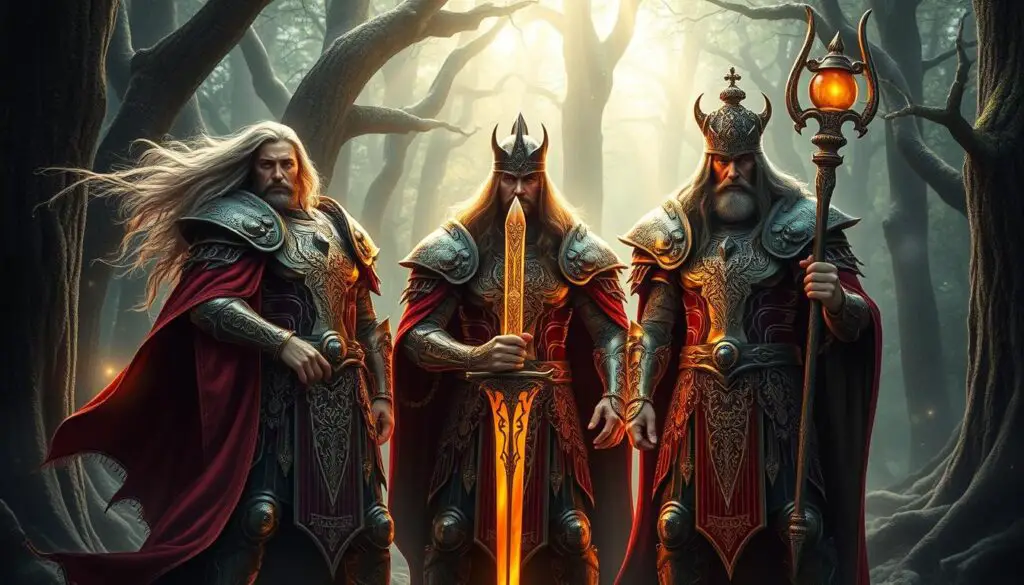
The arrival of the Milesians in Ireland heralded a significant clash with the established divine race, the Tuatha Dé Danann.
As the new settlers landed, they found themselves in direct conflict with the proud and magical inhabitants who were renowned in ancient Irish mythology for their exceptional prowess.
The Division of Ireland
After a series of fierce confrontations and intense negotiations, a remarkable settlement was reached between the two sides.
The island was to be divided— the Milesians would rule the surface, covering the secular dominion of Ireland. In essence, the Tuatha Dé Danann receded into the ‘sídhe’ or the mystical ‘Otherworld.’
This arrangement signified not only a literal division of the land but also reflected a deeper, mystical partition.
The once-dominant race of gods and heroes would now preside over the spiritual and hidden aspects of the island, maintaining their distinct influence over the land’s sacred and magical elements.
Significance of the Otherworld
The division stipulated that while the Milesians governed the visible realm, the Otherworld significance could not be understated.
The retreat of the Tuatha Dé Danann into the sídhe epitomized a profound shift in the island’s dynamics.
According to ancient Irish mythology, the Otherworld was not just a retreat but a realm parallel to the mortal world, inhabited by entities with supernatural abilities.
It was believed to be accessible through certain glades, caves, and lakes, known as sídh mounds.
This mythical arrangement underscored the diminishing of ancient pagan rites while embracing new sovereign rulers, thus bridging the realms of myth and mortal governance.
Role of Amergin and the Kingship Division
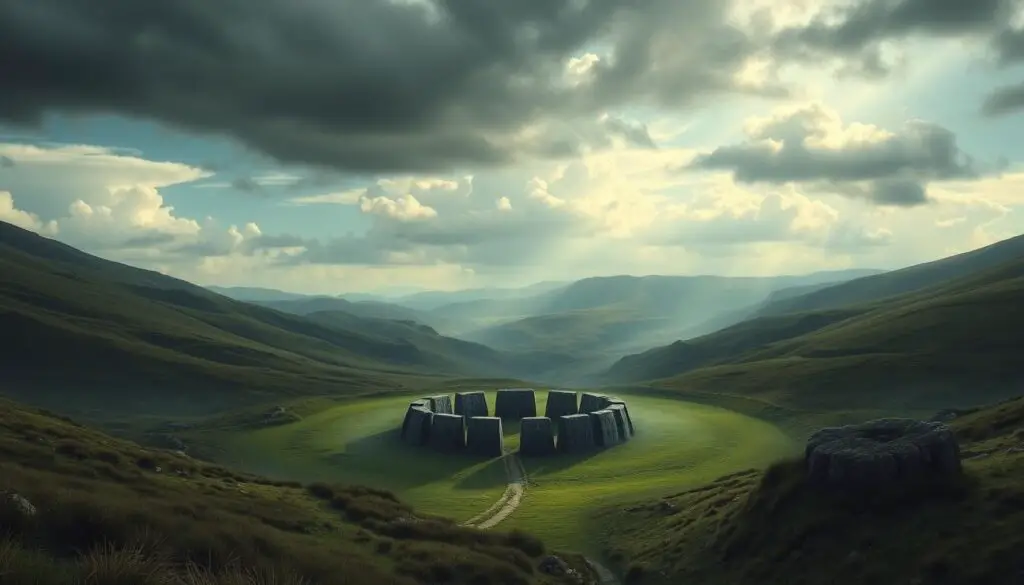
Amergin, the legendary poet and druid, was a pivotal figure in the Milesian legacy.
His poetic incantations not only enabled the Milesians to reach the shores of Ireland but also legitimized their claim to the land.
The role of Amergin poet was integral in the ancient narrative, setting the stage for the ultimate kingship division of Ireland.
Amergin’s Poetic Influence
In Irish mythology, Amergin’s poetic prowess was unmatched. As the son of Míl Espáine, he was appointed the Chief Ollam of Ireland by his brothers, Éremon and Éber Finn.
His ability to invoke the elements through his poetry provided the Milesians with the divine approval they sought.
This spiritual endorsement was crucial in overcoming the Tuatha Dé Danann and establishing the Milesian legacy in Ireland.
The Division of the Land between Éremon and Éber Finn
Following their victory, the Milesians faced the challenge of dividing Ireland. Amergin played an essential role as a mediator, ensuring a fair kingship division between his brothers.
The island was divided into two territories: Éremon ruled the northern half, while Éber Finn governed the southern portion.
This division laid the foundation for future political and geographical boundaries, echoing the ancient narratives of the Lebor Gabála Érenn.
These historical divisions are still evident today. The modern geographical and political divisions of Ireland can trace their roots back to the ancient partitioning made by various invaders.
Each province had unique attributes, with Meath symbolizing kingship and high-dignity.
The ongoing political strife between the Republic of Ireland and the United Kingdom continues to reflect these ancient associations.
Amergin’s role was not just as an adjudicator but as a unifier, symbolizing the collective identity of the Milesian people.
The significance of his poetic influence and the subsequent kingship division underscore his lasting impact on Irish culture and history.
Mythological and Historical Interpretations

The narrative of the Milesians offers a rich tapestry of mythological and historical interpretations that captivate scholars and enthusiasts alike.
The interplay between medieval Christian influence, Milesian myth interpretations, and mythical comparisons sheds light on the depth and complexity of this ancient lore.
Medieval Christian Writers’ Influence
Medieval Christian writers played a crucial role in shaping the narrative of the Milesians.
Their influence aimed to align Irish history with biblical events and figures, creating a cohesive story that fit within the broader context of Christian theology.
By integrating elements from the Old Testament, these writers crafted a history that portrayed the Milesians as part of a divine plan, thus asserting Ireland’s place within the Christian worldview.
Comparisons with Other Mythologies
When examining Milesian myth interpretations, it’s essential to draw mythical comparisons with other Indo-European traditions.
The Milesians bear striking resemblances to figures and narratives found in Greek, Roman, and Norse mythologies.
These similarities suggest a shared cultural heritage or the widespread dissemination of common archetypal stories.
By analyzing these mythical comparisons, we can better understand the interconnectedness of ancient civilizations and their myth-making processes.
Cultural and Historical Legacy of the Milesians
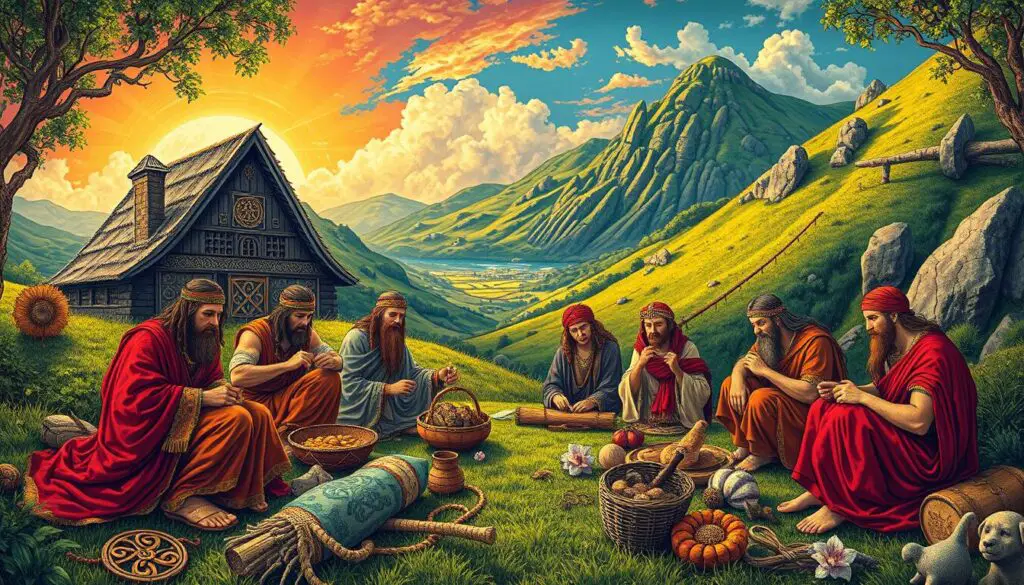
The influence of the Milesians on Irish history and culture is profound, particularly when considering their impact on Irish dynasties and the intricate ways they secured political legitimacy.
Scholars often point to the legends surrounding the Milesians to understand the broader Milesian cultural impact on Ireland.
Impact on Irish Dynasties
Irish dynasties extensively utilized the myth of the Milesians to consolidate their power.
Throughout centuries, various ruling families claimed direct descent from the Milesians to validate their authority.
This lineage claim is deeply embedded in the national identity, emphasizing the credence and respect commanded by these ancient figures.
Legitimacy and Political Use
The Milesian narrative was not just a tale to be told; it served a pivotal role in legitimizing political rule.
By anchoring their origins in the mythic and divine, Irish rulers augmented their political legitimacy in turbulent times.
This strategic use of mythology strengthened their positions, which is evident in numerous historical documents and literature.
The cultural legacy of the Milesians continues to be a focal point for historians and scholars, particularly in how it shapes perceptions of authority and heritage in Irish society.
Their influence extends beyond mere myth into the realms of social and political structures, showcasing the enduring relevance of their story.
Scythian and Iberian Connections in Detail
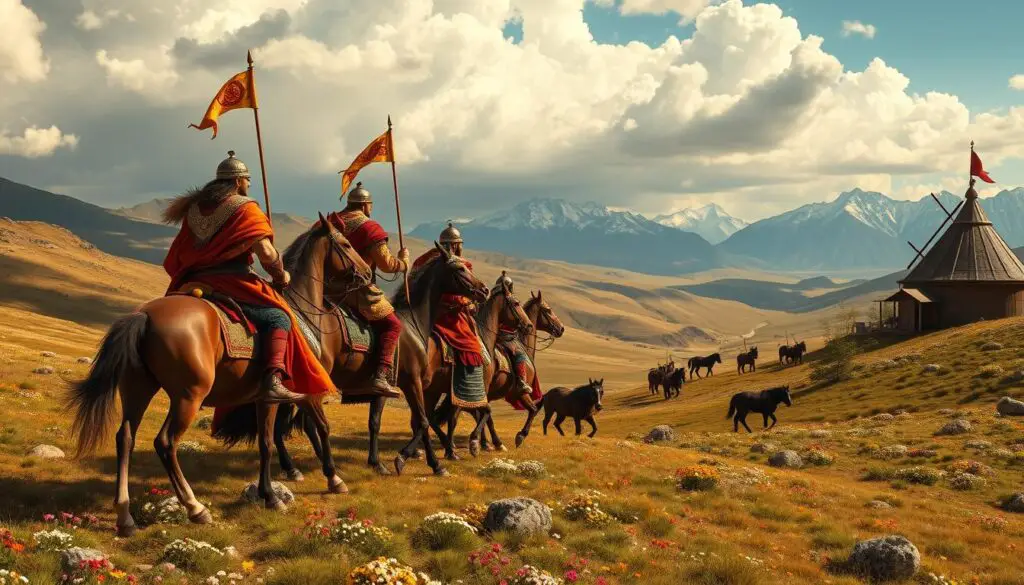
The Milesian legend intricately weaves together Scythian connections and Iberian migrations, depicting a fascinating yet complex migratory path for the Gaels before their final settlement in Ireland.
According to Irish annals, the Milesians, originally from Spain, are speculated to have invaded Ireland around the end of the second millennium B.C.
Interestingly, the term “Milesians” is prevalent in ancient Turkey and Spain, suggesting a possible relation between these regions.
The city of Miletus, one of the richest in the Greek world during the sixth century B.C., established numerous colonies, particularly in the north, highlighting the expansive trade network and cultural connections that could have influenced Celtic migrations.
Moreover, genetic evidence points to Irish Gaels having ancestry in the Pontic Steppe with genetic affinities to modern populations in Ireland, Wales, and Scotland.
Historians Benito Vicetto and Manuel Murguía played pivotal roles in promoting Celticism in Galicia, emphasizing the connection between Celtic migrations and the settlements in Galicia and Ireland.
This romantic notion of identity perpetuates the belief that the Milesians originated from Brigantia in Spain, aligning with Isidore of Seville’s “Etymologies” and its influence on Irish culture.
The interest in Celticism was significantly bolstered by James Macpherson’s translation of the Poems of Ossian in 1765, fueling further exploration of these ancient connections.
Vicetto’s seven-volume “Historia de Galicia”, published between 1865 and 1873, extensively discusses the presence and influence of the Celts in this region, thereby perpetuating cultural and historical ties between Galicia and Ireland.
Isidore of Seville’s works, particularly “De rerum nature” and “Etymologies”, which influenced Irish biblical commentaries and natural philosophy, suggest a rich conduit of cultural exchange.
The ancient stories of the Milesians and their supposed Scythian and Iberian origins continue to enchant and inform perceptions of Irish lineage, despite modern genetic evidence.
Modern Scholarly Perspectives on the Milesians
Scholarly debates about the Milesians reflect a rich tapestry of historical and mythological intersections.
Many historians view the Milesian narrative as a pseudo-historical construct, primarily designed to establish a sense of national identity and origin.
This perspective suggests that the legend of the Milesians was not merely a tale of ancient settlers but a means to weave Ireland’s prehistoric past with the broader mythos of human civilization.
Debates Among Historians
The historical debates surrounding the Milesians are vast and complex. Scholars like Geoffrey Keating and the compilers of the Annals of the Four Masters have contributed to these debates with their interpretations of early Irish history.
Modern researchers scrutinize these views, comparing the Milesian legend to historical accounts and archaeological data.
They explore how such narratives might have been influenced by medieval Christian writers seeking to integrate the Irish past with biblical stories, thus lending an air of divine legitimacy to Ireland’s ancient lineages.
Archeological Evidence
When examining archeological evidence, the challenge often lies in correlating tangible findings with legendary accounts.
While archaeology has shed light on prehistoric human activity in Ireland, direct evidence supporting specific claims made in the legend of the Milesians remains elusive.
Excavations reveal extensive settlements, trade networks, and cultural artifacts dating back to the Neolithic period, yet the direct traces of the Milesians themselves are scarce.
This ongoing investigation underscores the complexities inherent in distinguishing myth from historical fact, highlighting the continuous exploration necessary for understanding the true origins of such legends.
Frequently Asked Questions
Q: Who was in Ireland before the Milesians?
Before the Milesians, Ireland was inhabited by the Tuatha Dé Danann, who were considered to be a race of god-like beings with supernatural powers in Irish mythology.
Q: When did the Milesians invade Ireland?
The Milesians are said to have invaded Ireland in the mythical past, with no specific date attached to their arrival. Their story is a foundational myth of Irish history, symbolizing the arrival of the final wave of Celtic influence.
Q: How did the Milesians defeat the Tuatha Dé Danann?
The Milesians defeated the Tuatha Dé Danann through a combination of battle prowess and mystical interventions, including invoking a magical storm that proved decisive. Following their defeat, the Tuatha Dé Danann were believed to retreat into the Otherworld.
Q: What is the difference between the Milesians and the Tuatha Dé Danann?
The main difference lies in their nature: the Tuatha Dé Danann are described as god-like beings with magical powers, while the Milesians are considered mortal humans who represent the Gaelic ancestors of the Irish people.
Q: Who were the Milesian philosophers?
The term ‘Milesian philosophers’ typically refers to the group of pre-Socratic philosophers from Miletus, in ancient Greece, not related to Irish mythology. They include Thales, Anaximander, and Anaximenes, who were among the first to propose rational explanations for natural phenomena without recourse to mythology.


